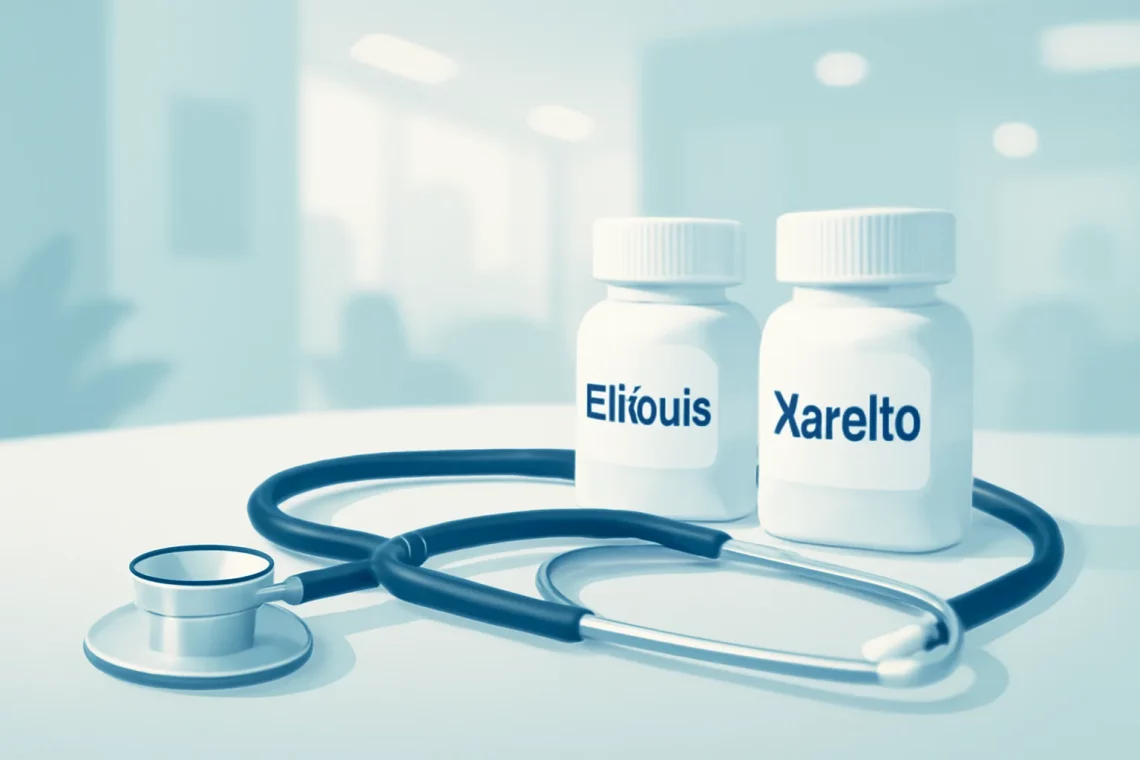
Eliquis vs Xarelto Which Anticoagulant is Right for You
Anticoagulants play a crucial role in modern medicine, especially for patients at risk of developing blood clots. Two of the most commonly prescribed anticoagulants are Eliquis (apixaban) and Xarelto (rivaroxaban). Both medications belong to a class of drugs known as direct oral anticoagulants (DOACs) and are used to reduce the risk of stroke and blood clots in patients with conditions such as atrial fibrillation or venous thromboembolism.
The choice between Eliquis and Xarelto can be a significant decision for both patients and healthcare providers. Factors such as efficacy, safety profiles, dosing regimens, and potential drug interactions must be considered. Each medication has its unique characteristics that can influence treatment decisions based on individual patient needs. Understanding these differences is essential for ensuring optimal patient outcomes and managing the risks associated with anticoagulation therapy. As more patients are prescribed these medications, the need for clear and accessible information about their use, benefits, and drawbacks becomes increasingly important.
Eliquis Overview
Eliquis, generically known as apixaban, is an oral anticoagulant that acts as a direct factor Xa inhibitor. It works by blocking the activity of factor Xa, an essential component in the blood coagulation process, thereby reducing the ability of blood to clot. Eliquis is commonly prescribed for various conditions, including the prevention of stroke in patients with nonvalvular atrial fibrillation, the treatment of deep vein thrombosis (DVT) and pulmonary embolism (PE), and the prevention of DVT and PE following certain types of surgery.
One of the significant advantages of Eliquis is its favorable safety profile. Clinical studies have shown that it is associated with a lower risk of major bleeding events compared to some traditional anticoagulants, such as warfarin. This safety aspect is particularly important for elderly patients or those with comorbid conditions that may increase bleeding risk.
Eliquis is typically taken twice daily, and its dosing can be adjusted based on renal function and other patient-specific factors. This flexibility allows healthcare providers to tailor the medication to individual patient needs. Importantly, Eliquis does not require routine monitoring of blood levels, which simplifies the management of anticoagulation therapy and enhances patient adherence to treatment.
However, like all medications, Eliquis is not without its drawbacks. The cost can be a significant barrier for some patients, especially those without insurance coverage or with high copays. Additionally, patients taking Eliquis must be cautious about potential drug interactions, particularly with other anticoagulants, antiplatelet medications, and certain antibiotics.
Xarelto Overview
Xarelto, or rivaroxaban, is another direct factor Xa inhibitor that is widely used in anticoagulation therapy. Similar to Eliquis, Xarelto is indicated for the prevention of stroke in patients with nonvalvular atrial fibrillation, treatment of DVT and PE, and the prevention of these conditions following surgical procedures.
One of the distinguishing features of Xarelto is its once-daily dosing regimen for most indications, which can enhance patient compliance compared to medications that require more frequent dosing. This convenience can be particularly beneficial for patients managing multiple medications.
Xarelto also has a well-established efficacy profile. Clinical trials have demonstrated its effectiveness in reducing the risk of stroke and systemic embolism in patients with atrial fibrillation. Its rapid onset of action allows for immediate anticoagulation effects, which can be critical in acute clinical situations.
However, the safety profile of Xarelto has raised some concerns. Although it is generally considered safe, studies have indicated a higher incidence of major bleeding events compared to Eliquis. This increased risk is an essential consideration for healthcare providers when prescribing Xarelto, particularly for patients with a history of bleeding disorders or those at high risk of falls.
Like Eliquis, Xarelto does not require routine monitoring, which is a significant advantage for patients. However, it is essential to be aware of potential drug interactions, particularly with medications that affect liver enzymes. These interactions can influence the levels of Xarelto in the bloodstream, potentially leading to increased bleeding risk or reduced efficacy.
Comparative Efficacy and Safety
When comparing Eliquis and Xarelto, it is essential to evaluate their efficacy and safety profiles critically. Both medications have been shown to be effective in reducing the risk of stroke and systemic embolism in patients with atrial fibrillation. However, differences in their safety profiles have led to varied recommendations in clinical practice.
Several large-scale clinical trials have compared the two medications head-to-head. These studies have found that Eliquis is associated with a lower risk of major bleeding events compared to Xarelto. This safety profile can be particularly important for certain patient populations, such as the elderly or those with additional risk factors for bleeding.
Furthermore, Eliquis has demonstrated superior outcomes in terms of overall mortality rates. Patients taking Eliquis have shown a reduced risk of death from all causes compared to those on Xarelto. This finding may influence treatment decisions, particularly for patients with significant comorbidities.
Cost considerations also play a role in the choice between these two medications. While both Eliquis and Xarelto can be expensive, the pricing structure may vary based on insurance coverage and patient assistance programs. Patients should consult with their healthcare providers to explore options for reducing their out-of-pocket costs.
Ultimately, the choice between Eliquis and Xarelto should be individualized based on patient-specific factors, including renal function, bleeding risk, and preferences regarding dosing regimens. Engaging in a shared decision-making process with healthcare providers can help ensure that patients receive the most appropriate therapy for their clinical situation.
Patient Considerations and Lifestyle Implications
When it comes to choosing between Eliquis and Xarelto, patient considerations and lifestyle implications are paramount. Both medications require patients to make certain lifestyle adjustments to ensure optimal treatment outcomes and minimize risks.
For patients on Eliquis, adherence to the prescribed twice-daily dosing schedule is crucial. This medication can be taken with or without food, providing flexibility in administration. However, patients should be advised to maintain consistent eating habits, as changes in diet may impact the absorption of other medications they may be taking.
Xarelto, on the other hand, is typically taken once daily and should be taken with food to enhance absorption. This requirement can be an important factor for patients who are accustomed to irregular meal patterns or those who may skip meals.
Education on recognizing signs of bleeding is essential for patients on both medications. Patients should be informed about the symptoms of major bleeding, such as unusual bruising, prolonged bleeding from cuts, or blood in urine or stool. They should also be advised to avoid activities that increase the risk of injury, such as contact sports or high-impact exercises.
Additionally, patients should be informed about the importance of regular follow-up appointments with their healthcare providers. These visits can help monitor renal function, assess for any potential drug interactions, and evaluate overall treatment efficacy.
Lastly, support systems play a crucial role in medication adherence. Encouraging family members or caregivers to participate in discussions about anticoagulation therapy can help reinforce the importance of consistent medication use and lifestyle modifications.
In conclusion, while both Eliquis and Xarelto offer effective options for anticoagulation therapy, the choice between them should be guided by individual patient needs, lifestyle considerations, and a thorough evaluation of their safety and efficacy profiles.
—
**Disclaimer**: This article is not intended as medical advice. Always consult your healthcare provider for medical concerns and before starting or stopping any medication.




